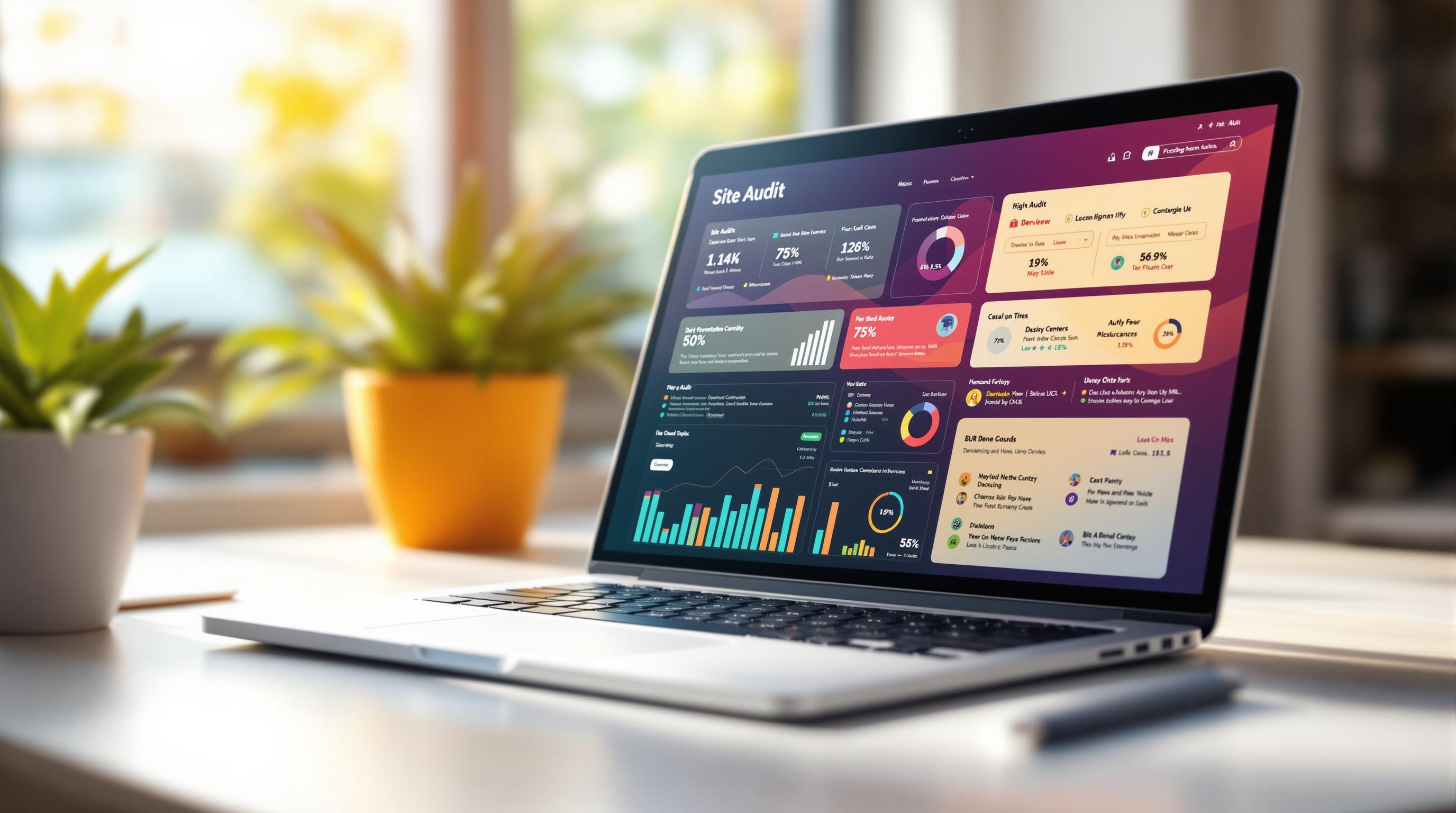Meta titles are crucial for SEO. They help search engines rank your page, improve click-through rates, and ensure your content aligns with user intent. Here’s how to optimize them:
- Keep it concise: Stay within 50-60 characters to avoid truncation.
- Prioritize keywords: Place important keywords at the beginning.
- Make them unique: Avoid duplicate or generic titles.
- Use tools: Tools like Yoast SEO and SEMrush can help refine your titles.
- Avoid mistakes: Steer clear of keyword stuffing and overly long titles.
Quick Tip: Tools like Yoast SEO provide real-time feedback, and SEMrush helps detect issues like duplicate titles. Start optimizing today to boost your site’s visibility and clicks.
The Role of Meta Titles in SEO
What Are Meta Titles and Why Do They Matter?
Meta titles are the short phrases that describe a webpage's content and play a key role in SEO. These titles, when kept under 60 characters, are displayed correctly in search results about 90% of the time [2]. This ensures they appear as intended, helping maintain visibility and consistent branding.
A strong meta title not only tells search engines what the page is about but also helps it rank for specific keywords and encourages users to click on the link.
To make the most of meta titles, it’s important to know how search engines interpret and use them.
How Search Engines Handle Meta Titles
Search engines like Google use meta titles as a ranking factor to determine how relevant your content is. On desktop, titles are cut off at 525-535 pixels, so placing important keywords at the beginning is key [4]. Research shows that starting with target keywords can improve how your page performs [4].
These days, search engines prioritize titles that align with user satisfaction. Several factors influence how well a meta title performs:
| Factor | Effect on Search Results |
|---|---|
| Keyword Relevance | Helps determine rankings for specific search terms |
| Character Length | Impacts how the title appears in search results |
| User Intent Match | Reduces the chances of Google rewriting the title |
| Click-Through Rate | Affects rankings and overall search performance |
17 Secrets of SEO Title Tags
Steps to Create Effective Meta Titles
Crafting meta titles that attract both search engines and users requires a few key steps. Here's how to get started.
Keyword Research for Titles
Using tools like SEMrush's Keyword Magic Tool can help you find keywords with high search volume and low competition [4]. Focus on terms that match user intent, have decent search volume, manageable competition, and align with your content's goal.
| Factor to Consider | Why It Matters for Meta Titles |
|---|---|
| Search Volume | Shows potential for driving traffic |
| Competition Level | Helps gauge how hard it is to rank |
| User Intent Match | Boosts click-through rates |
| Keyword Length | Impacts how much space the title uses |
Once you've settled on the right keywords, the next step is weaving them seamlessly into your meta titles.
Guidelines for Writing Meta Titles
Follow these tips to ensure your titles are clear, relevant, and optimized for both users and search engines:
- Place important keywords near the beginning for better visibility.
- Stick to either sentence case or title case throughout.
- Add your brand name at the end, separated by a pipe (|).
- Make sure every page has a unique meta title.
- Keep the title aligned with the page's content and purpose.
Example: "Buy iPhone 15 Pro Max | Best Deals 2025"
Using Emotional and Power Words
Incorporating emotional and power words can help increase click-through rates without compromising SEO [2][3]. Words like "Ultimate", "Exclusive", "Discover", "Essential", and "Proven" can make your titles more engaging. Use these sparingly to keep your titles authentic while still grabbing attention.
"Keyword research and engaging language are the foundation of effective meta titles, enhancing both SEO and user engagement" [1][3].
Once you've nailed the keywords and tone, tools can help you fine-tune your titles for maximum impact.
sbb-itb-d7fe25c
Tools for Analyzing and Optimizing Meta Titles
SEO tools make creating effective meta titles much easier. Here are some of the best options available today.
Overview of Meta Title Tools
There are several tools designed to help you analyze and improve your meta titles for better search results:
| Tool | Key Features | Ideal For |
|---|---|---|
| Yoast SEO | Real-time title feedback, length checker, keyword guidance | WordPress users |
| SEMrush | SEO audits, duplicate title detection, competitor analysis | Experienced users |
| BrightSide SEO | Keyword research, competitor insights, performance tracking | Small businesses |
Let’s take a closer look at how these tools can improve your meta titles.
Using Yoast SEO and SEMrush

Yoast SEO provides instant feedback on your meta titles, ensuring they follow SEO best practices. Its color-coded alerts make it easy to spot and fix issues like length or keyword placement.
SEMrush goes further by detecting duplicate titles, overly long ones, or weak keyword use. It’s a great choice for identifying and resolving title-related issues.
"Regular SEO audits using tools like SEMrush can identify up to 40% more title-related issues compared to manual reviews, leading to significant improvements in search visibility" [5].
Why BrightSide SEO Works for Small Businesses

BrightSide SEO is a practical option for small businesses aiming to improve their online presence. It offers:
- Keyword Tracking: Monitors how specific keywords perform for your business.
- Competitor Insights: Analyzes competitor meta titles to find what works.
- Performance Reports: Delivers monthly updates on click-through rates and title effectiveness.
With features like keyword tracking and competitor analysis, BrightSide SEO helps small businesses refine their titles and improve search performance [2][6].
While these tools are helpful, steering clear of common meta title mistakes is just as important.
Common Mistakes to Avoid with Meta Titles
Keyword Stuffing and Over-Optimization
Keyword stuffing is one of the biggest missteps when it comes to meta titles. Search engines now penalize this practice, which can harm your visibility.
Here’s an example of what keyword stuffing looks like:
SEO Agency | Best SEO Services | SEO Experts
This kind of title not only looks unappealing to users but also signals low quality to search engines [4]. Instead, aim for natural, readable titles that include your main keyword in a strategic way:
Professional SEO Services | ResultsFirst Agency
Duplicate or Generic Titles
Using the same title across pages or generic ones can confuse both users and search engines. Google’s research shows that unique, descriptive meta titles perform better in terms of click-through rates compared to generic ones [4].
Here’s how industries can avoid generic titles:
| Industry | Poor Title | Optimized Title |
|---|---|---|
| E-commerce | Shop - Generic Store Name | Buy Organic Coffee Beans | Free Shipping |
| Tech Blog | Blog Post | Latest iPhone 15 Review: Features & Analysis |
| Travel | Destinations | Affordable Summer Vacations in Italy 2025 |
Truncated Titles and Length Issues
Meta titles that are too long often get cut off in search results, hiding important details. Research shows that truncation typically starts between 525-535 pixels on desktop screens [4].
"SEO audits show that 40% of websites have titles that get cut off, reducing visibility and clicks." [4]
To avoid this, keep your titles between 50-60 characters and make sure to include key terms at the beginning. Here are some additional tips:
- Preview titles using tools like Yoast SEO to see how they’ll appear in search results
- Test titles on both desktop and mobile devices
Keep in mind that mobile devices may display slightly longer titles, but sticking to concise, clear titles ensures consistency across platforms [2][4].
Conclusion: Key Points for Optimizing Meta Titles
Checklist for Crafting Meta Titles
Here's a quick rundown of the key elements to focus on when creating meta titles:
- Unique Titles: Ensure every page has its own meta title that matches the content accurately [4].
- Keywords Done Right: Use your main keyword naturally - avoid keyword stuffing or going overboard [2].
- Mobile-Friendly: Check how your titles display on different devices [4].
- Brand Mention: Include your brand name at the end, separated by a vertical bar (|) [2].
| Component | Best Practice |
|---|---|
| Length | 50-60 characters (525-535 pixels) |
| Keyword Placement | Place the primary keyword first |
| Structure | Main term + Modifier + Brand |
Putting It All Into Practice
Now it’s time to put these tips to work and see real progress in your SEO results.
"SEO audits show that 40% of websites have titles that get cut off, reducing visibility and clicks." [4]
Start with tools like Yoast SEO or SEMrush to track and tweak your titles. Focus on high-traffic pages first, measure the impact, and then expand to other areas of your site. This step-by-step process will help boost your site’s visibility and attract more organic traffic.
FAQs
Here are some clear answers to common questions about meta titles to help you optimize them effectively.
How to write a good SEO meta title?
To craft a strong SEO meta title, focus on a few key elements. Keep it between 50-60 characters to avoid getting cut off in search results [2]. Place your main keyword at the beginning for better visibility [4].
A great format to follow includes: a primary keyword at the start, a value-focused modifier, and your brand name at the end. For example: "Digital Marketing Tips: Ultimate Guide | Company Name."
Keep in mind, Google might tweak your meta title if it thinks it doesn't match the page content [4].
What is the ideal length for a meta title?
Meta titles should stay within 50-60 characters (or 525-535 pixels) to display properly on desktop search results. Mobile screens might show slightly longer titles, but sticking to this range ensures your title looks good on all devices [2][4].
If your title gets cut off, it can hurt your click-through rate. So, aim for the right length, and make sure it includes all the necessary details while staying concise.


